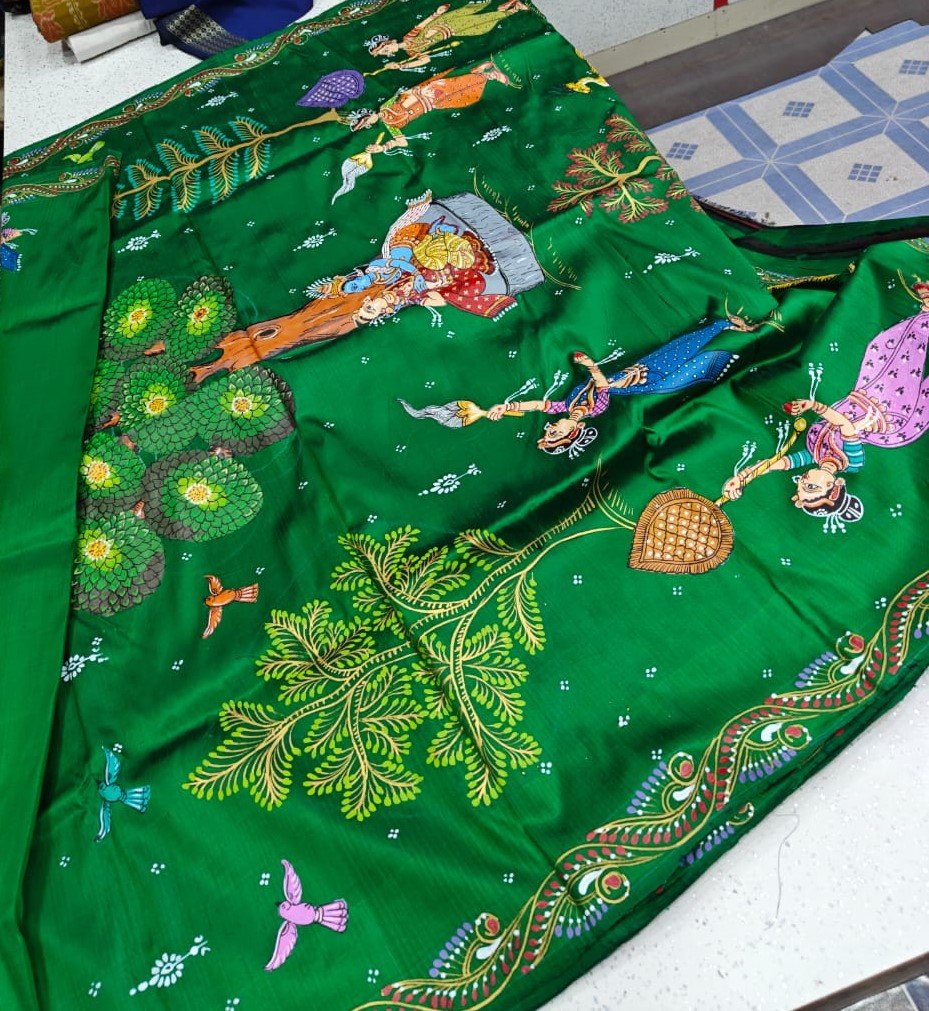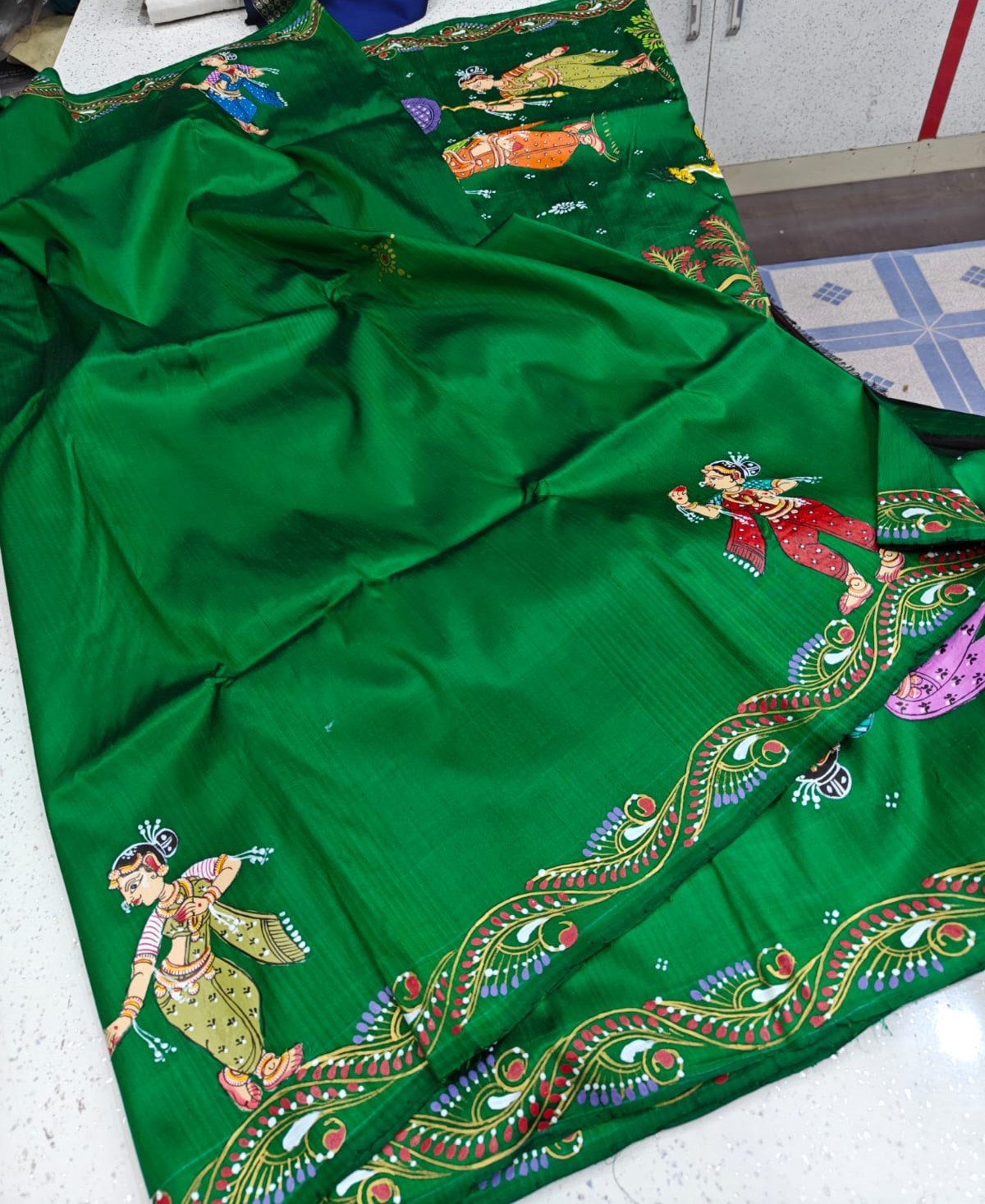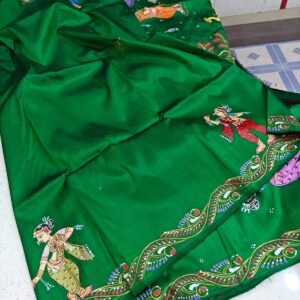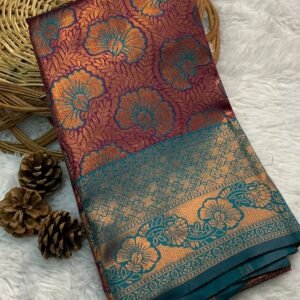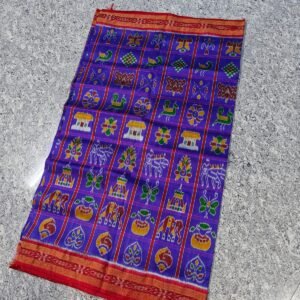Patachitra Silk Saree Green
₹16,000.00 Original price was: ₹16,000.00.₹15,000.00Current price is: ₹15,000.00.
Buy more save more!
Buy from 3 to 5 items and get ₹2.00 OFF
on each productBuy from 6 to 8 items and get ₹3.00 OFF
on each productBuy from 9 to ∞ items and get ₹5.00 OFF
on each productPatachitra art, a traditional painting style indigenous to Odisha, boasts a rich heritage that dates back to ancient times. The word “Patachitra” is derived from the Sanskrit words “Pata,” meaning cloth, and “Chitra,” meaning painting. Historically, Patachitra paintings were created on cloth and later on dried palm leaves, capturing the essence of Odisha’s cultural and religious ethos. The art form is deeply intertwined with the Jagannath cult, prominently featuring in the rituals and festival paraphernalia of the Jagannath Temple in Puri.
The origins of Patachitra can be traced back to the 5th century BCE. Over centuries, it has evolved while retaining its unique characteristics such as intricate detailing, vibrant colors, and mythological themes. The artists, known as Chitrakars, traditionally use natural colors derived from minerals, stones, and organic materials. The themes often depict stories from Hindu mythology, particularly tales from the Ramayana, Mahabharata, and various incarnations of Lord Vishnu. The fine lines and meticulous craftsmanship reflect the devotion and skill of the artisans.
Patachitra art has significantly influenced various forms of art in Odisha, including its architecture, sculpture, and textiles. The motifs and designs often find their way onto the walls of temples, household items, and contemporary art forms. The intricate patterns and storytelling aspects of Patachitra have also inspired various folk dances, music, and literature in the region, creating a rich tapestry of cultural expression.
Preservation and promotion of Patachitra art have been paramount to ensuring its continuity. Various governmental and non-governmental organizations have taken initiatives to support the artisans and provide platforms for showcasing their work. Workshops, exhibitions, and art fairs are regularly organized to keep the tradition alive and introduce it to newer generations. Moreover, Patachitra’s adaptation onto silk sarees has brought the art form into the realm of fashion, making it accessible to a global audience and ensuring its timeless beauty endures.
The creation of Patachitra silk sarees is a testament to the intricate craftsmanship and immense dedication of the artisans involved. The process commences with the careful selection of high-quality silk, ensuring a smooth and lustrous base for the artwork. The silk is then treated and stretched over a wooden frame, providing a stable canvas for the meticulous hand-painting process that defines Patachitra art.
Artisans employ a variety of traditional tools and materials in their work. Natural dyes, derived from organic sources such as minerals and plants, are prepared to achieve the vibrant colors characteristic of Patachitra silk sarees. Traditional brushes, often made from the fine hair of squirrels, are utilized for their precision, enabling artisans to render intricate details with remarkable accuracy.
The design process typically begins with a rough sketch, which is then gradually filled in with layers of color and detail. The themes depicted on Patachitra silk sarees are deeply rooted in Indian culture, often illustrating scenes from Hindu mythology, folklore, and nature. Common motifs include tales of gods and goddesses, epic narratives like the Ramayana and Mahabharata, and elements of daily life and the natural world. Each saree tells a unique story, capturing the essence of Indian heritage and tradition.
However, maintaining the authenticity of Patachitra silk sarees in the modern market poses significant challenges. Artisans face the pressure of mass production and the influx of machine-made imitations, which can undermine the value of their painstaking handwork. Additionally, the labor-intensive nature of the craft, coupled with the rising costs of natural materials, presents economic challenges for traditional artisans. Despite these obstacles, the dedication of Patachitra artists ensures the preservation and continued relevance of this exquisite form of art, allowing it to captivate generations to come.

